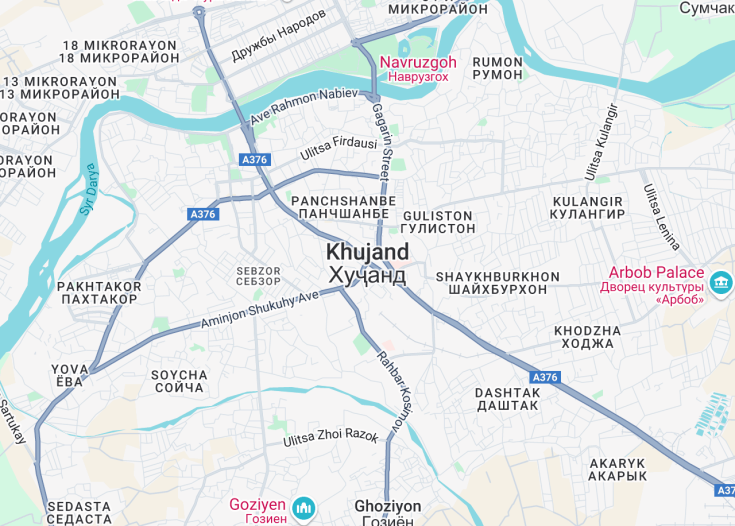Khujand, one of the oldest cities in Central Asia, is situated at the mouth of the Fergana Valley and serves as the northern capital of Tajikistan. This city, rich in history and culture, is known for its beautiful landscapes and strategic location on the ancient Silk Road. The Syr Darya River flows through the city, providing scenic views and fertile lands surrounding it. Khujand boasts architectural marvels such as the historical museum housed in a former mosque, and the bustling Panjshanbe Market, a vibrant hub of commerce and local culture, making it a compelling destination for history buffs and cultural enthusiasts alike.
Explore the Panjshanbe Market to immerse yourself in local culture. It’s an excellent spot for purchasing authentic Tajik crafts and tasting regional delicacies.
Visit the Khujand Fortress for a picturesque glimpse into the city’s rich historical tapestry. Best visited during early mornings for a serene experience.
Top things to do & see in Khujand
Select the following sights and activities to discover best tickets and tours available in Khujand.
Khujand: Gateway to the Fergana Valley
| Country | Tajikistan |
| Time in Khujand | GMT+5 |
| Language spoken | Tajik |
| Population | 174,000 (City Population Database 2023) |
| Currency | Somoni (TJS, сомонӣ) |
| Airports | Khujand Airport (5 mi / 8 km). |
Khuhand, located in the northern part of Tajikistan, serves as the administrative hub of the Sughd region. Strikingly positioned on the Syr Darya River at the mouth of the Fergana Valley, the city’s history dates back to over 2,500 years, making it one of the oldest cities in Central Asia. Originally founded as Alexandria Eschate (“the Furthest”) by Alexander the Great in around 329 BC, Khujand has been a significant trading post along the ancient Silk Road. It has witnessed numerous historical events, which have shaped the region including the spread of Islam, invasions by the Mongol hordes under Genghis Khan, and later inclusion within the Russian Empire and Soviet Union.
Today, Khujand stands as the second-largest city in Tajikistan and plays a pivotal role economically and culturally. The local economy benefits significantly from the agricultural wealth of the fertile Fergana Valley, famous for its production of fruits, especially apples and apricots. Moreover, the city has seen considerable redevelopment efforts, enhancing its infrastructure and tourism appeal. Historical sites like the Masjid Sheikh Muslihiddin and Panjshanbe Market, a bustling bazaar that dates back centuries, are notable attractions that showcase its rich heritage and cultural vibrancy.
As more travelers seek unique destinations that blend profound histories with charming local life, Khujand offers a captivating glimpse into an often-overlooked region rife with stories, scenic beauties, and warm hospitality that echoes its storied past.
Where is Khujand?
Khujand is positioned in northwestern Tajikistan, laying strategically along the Syr Darya River near the border with Uzbekistan.
Distances:
| Route | Distance by car | Time by car |
|---|---|---|
| Dushanbe to Khujand | 230 miles (370 km) | 5 hours |
| Tashkent to Khujand | 105 miles (169 km) | 2.5 hours |
What is Khujand famous for?
Khujand is renowned for its historical remnants such as ancient mosques and markets, contributing significantly to the Silk Road’s rich tapestry. It’s a cultural and economic hub that vividly showcases Tajik traditions through its vibrant markets and festivals.
History
Ancient Era (Before 329 BC)
Located in today’s northern Tajikistan, Khujand’s area has been populated since at least the 7th century BC, evident from archaeological relics. Positioned along the Syr Darya River and surrounded by fertile valleys, it was an attractive location for settlement by early tribes.
The Achaemenid Period to Alexander the Great (329 BC – 4th Century AD)
The area around Khujand became part of the expansive Achaemenid Empire during its zenith, serving as a critical outpost on the northeastern frontier. Captured by Alexander the Great in 329 BC, Khujand, then known as Alexandria Eschate, or “the Furthest,” marked the empire’s northeastern limit. Alexander’s arrival brought significant Greek cultural and architectural influences, remnants of which can still be discerned in Khujand’s ancient sites.
The Early Islamic and Timurid Era (8th – 16th Century)
Falling under Arab Muslim rule in the 8th century, Khujand became a center of Islamic learning and culture, with numerous scholars and poets originating from the city. The region experienced chaos during the Mongol invasions but eventually thrived under the Timurids, when the focus on arts and intellectualism was revitalized.
The Russian Imperial and Soviet Era (19th – 20th Century)
Khujand became a part of the Russian Empire in the late 19th century, marking its transition into a modern era. Soviet control beginning in the 20th century brought industrialization and modernization. The city expanded significantly during this period, with an emphasis on cotton production and processing, influencing the city’s demographic and urban landscape enormously.
Contemporary Khujand (21st Century)
In the contemporary era, Khujand is one of Tajikistan’s principal cities and an economic and cultural hub. Despite challenges post-Soviet Union independence, including economic transitions and infrastructural developments, Khujand has been navigating its path toward modernization while trying to retain its rich historical heritage.
Visit Khujand
What to see and do in Khujand
Khujand, a city steeped in history and culture, offers a plethora of sights and activities for visitors. Key attractions include the historical Khujand Fortress, showcasing the city’s resilient past and the Museum of Archeology and Fortification, housed within. The Panjshanbe Market, one of the busiest bazaars in Tajikistan, offers a vibrant taste of local life and traditional goods.
- Explore the architectural beauty of Masjid Sheikh Muslihiddin, a historical mosque and madrasah complex.
- Take a relaxing stroll along the Syr Darya River promenade.
- Visit the Regional Museum, which provides extensive insights into the region’s history and culture.
Cultural Celebrations in Khujand
Khujand plays host to various cultural festivals and events throughout the year, enriching its social landscape. Notable among these are the Navroz festival in March, celebrating the Persian New Year with colorful displays and traditional festivities, and the Melon Festival in August, which honors the region’s agricultural heritage with tastings and cultural performances.
Best time to visit Khujand
Tourists can best experience Khujand during spring (March to May) and early autumn (September to November). These months offer pleasant weather, conducive to exploring the city and participating in outdoor activities without the extreme summer heat or the harsh winter cold.
Is Khujand worth visiting?
Khujand is undoubtedly worth visiting for those who appreciate history and culture intertwined with the vibrancy of modern-day life. Despite its somewhat remote location and the challenges of traveling in Central Asia, the city offers a rich tapestry of historical landmarks combined with a lively marketplace atmosphere. However, visitors should be prepared for potential logistical challenges and a significant language barrier. Overall, Khujand promises a rewarding experience for those eager to delve into its profound historical and cultural depths.










